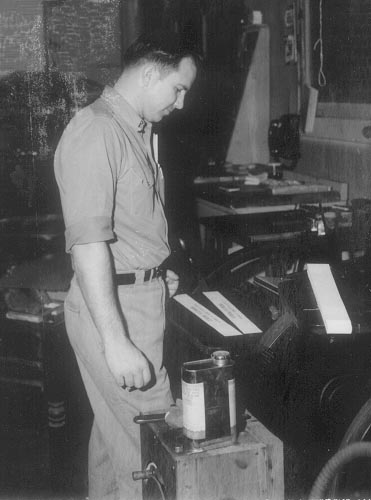THE PRINTER’S DEVIL
West Intermediate School in Jackson, MI was graced with Pono’s presence for seventh grade. In addition to the three R’s, I was forced to take the embarrassing “Naked Swimming for Boys”, but due to great foresight by the administrators, I was also allowed to take a choice of Industrial Arts classes. I chose “Printing”. This was not “Penmanship” or “Calligraphy”, but rather “Printing” as in Gutenberg, movable type and printing presses.
I learned how to set movable type from a California type case with a composing stick. I learned how to set up a form and lock it into a chase for printing. I learned how to run a simple letterpress. I learned a bit about paper – the wire and felt side, stock grades, standard sizes and quantities. And I learned that printer’s ink soaked into the innermost recesses of hands, fingers and any other body part it touched – never to be removed. I passed the class and moved on to the next town and the next grade.
Perry Rural Agricultural School in Perry, MI and eighth grade was next. In his youth, my father had completed eighth grade and went to work, so I guess he started wondering if I was going to just keep on schooling and waste my life. He encouraged me to look into a job with Watkins Publishing Co., the local job printing shop and publishers of the weekly Shiawassee County Journal. What with my formal training in their business, how could they say no? I was hired to work part time for 35¢ an hour. Between 1946 and 1962, Watkins was always there for me when I needed part time or short term employment.
Of course I started as a “Printer’s Devil”, sweeping floors, redistributing pie (scrambled movable type), and setting type, but over the years I did everything there was to do from the necessary menial chores to the more sophisticated ones. I assembled the articles, advertising, and illustrations for the newspaper; composed the type for job printing; ran the presses (both the manual feed and later the auto-feed Heidelberg); broke down the newspaper and job printing forms and cleaned up constantly; occasionally ran the linotype machine; took pictures at various events; and even wrote articles for the paper at times. But there is one chore that I thoroughly enjoyed at the time, and can’t think of today without a shudder running up my spine.
The linotype machine set the type for articles in the newspaper. A typewriter-like keyboard caused forms with indented images of letters to assemble in a row, spacing was applied to make a full “line of type”, liquid metal was poured into the forms, and a type-high line came bouncing out, ready to be put in a newspaper form and printed.
The metal used for these lines was mostly lead alloyed with antimony. Antimony has the property of shrinking slightly when it cools, so it comes out of the letter forms easily. The linotype has a smallish pot with a heater that liquefies the metal, and the pot is fed by ingots of metal that are about 2.44 feet long with an oblong “handle” on one end. Linotype metal is expensive but fortunately, almost totally recyclable. One of my jobs was to recycle the metal.
We had a big pot with a firebox under it. When the newspaper and print jobs were broken down, all linotype and illustration metal was dumped into the pot. When the ingot pile behind the linotype was nearly out, it was necessary to recycle. I’d build a fire under the pot and soon the metal would start melting. As it did, I would go through the office and gather everything I could find made of this metal that was expendable. I had a big ladle to stir the pot and a scientific method of checking the temperature that involved plunging a piece of newsprint in the metal quickly and evaluating the color change on the parched paper.
When the metal was “just right”, I would skim the dross (dust, dirt, paper scraps, ink, whatever) floating on the top and I was ready to pour ingots. We had six or eight ingot forms and they would be laid out on asbestos sheets to protect the floors from the heat. I’d use the ladle to fill each form, let them cool, lug them out near the linotype, turn the ingots out of the forms, let them cool a bit more, and pile them up for another cycle.
In the Michigan winters, the little room containing the pot was very pleasant. The heat, the smell of scorched newsprint, the beauty of the clean, shiny, molten metal are all memories that make me smile. So why do I shudder?
Both lead
and antimony are now known to be health hazards. Government and industrial
standards and regulations govern how these metals are handled and how much
exposure is acceptable. Now, recycle days were no doubt high exposure days,
but the linotype was melting metal almost constantly during normal working
hours. I have no idea how my exposure fits into current regulations, but I
know we didn’t worry about it back then. Besides that, I was protected – I
always wore gloves and an apron when I worked with the hot metal. They were
good, sturdy, work gloves and a heavy apron, both made of asbestos! Shudder!

Pono at the Heidelberg press at Watkins in 1961
[Visitor number
]